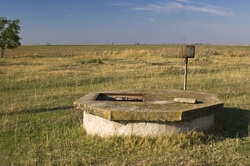According to the Texas Groundwater Protection Committee, there may be more than 150,000 abandoned water wells and groundwater monitoring wells in Texas. In the U.S. and Texas, more than half of the population depends upon groundwater for drinking water, which makes groundwater a very important economic resource to protect for public health and welfare. Texas State regulations spell out who can plug wells and how plugging must be completed.
Why are there so many abandoned wells in Texas?
Landowners are legally responsible for abandoned wells on their property. Any well drilled into the subsurface, regardless of how constructed, has the potential to harm children or pets that may fall into an open well, or be a pathway for surface contamination to reach important water bearing zones and/or aquifers.
Contamination can include many things such as chemicals, fertilizers, saline water, petroleum hydrocarbons, bacteria or other substances that can degrade the quality of groundwater. Abandoned wells also have the potential to contaminate one or multiple water bearing zones depending on depth and the geologic layers penetrated during drilling. Contamination entering groundwater zones can render the groundwater degraded and unusable or be a potential health threat.
Who can plug wells in Texas?
Well plugging is regulated under the Texas Administrative Code section 76.105 for technical specifications and under Texas Occupations Code Sections 1901 and 1902 for well driller licensure. Landowners can plug wells on their property following the Texas Commission on Environmental Quality (TCEQ) guide “Landowner’s Guide to Plugging Abandoned Water Wells.” Plugging information is also available from the TCEQ, Groundwater Conservation Districts, or local licensed water well drillers. If not plugged by landowners then wells must be plugged by a licensed well driller.
How are wells plugged?
Abandoned wells are plugged following these generalized steps.
Determine well details: Obtain well log, determine depth, diameter, feet of standing water to select proper plug methods and materials.
Prep well: Remove casing if possible. If not, cut at least 4 feet below ground surface, clean debris from well, “shock” standing water with a bleach/water solution of 100 parts per million bleach to kill bacteria.
Plug well: Fill with approved materials based on diameter and depth of well, cap with 2-feet cement in upper 4 feet, slope top for drainage, file a well plugging report on Texas Well Report Submission and Retrieval System.
Approved well plugging materials:
- Bentonite chips – typically used in wells less than 100 feet deep; pour alternately with water to hydrate chips, care to avoid bridging of chips.
- Bentonite grout – for any well but typically wells more than 100 feet deep; do not use when chlorides exceed about 1,500 parts per million, inject with tremie tube under pressure from bottom up.
- Cement slurry – use as for bentonite grout; may use other approved plugging materials within 100 feet of ground surface, no cement cap is required when using cement slurry for well plugging.
More stringent requirements may apply to your abandoned well depending on the age, depth or location; for example, abandoned wells that may be located above the Edwards Aquifer in Texas. Be sure to check local regulations to determine if special conditions exist.
Talon/LPE is an environmental drilling firmed that has plugged thousands of wells throughout Texas, Oklahoma and New Mexico. Contact our experienced team today for more information about our well plugging and environmental drilling services.

